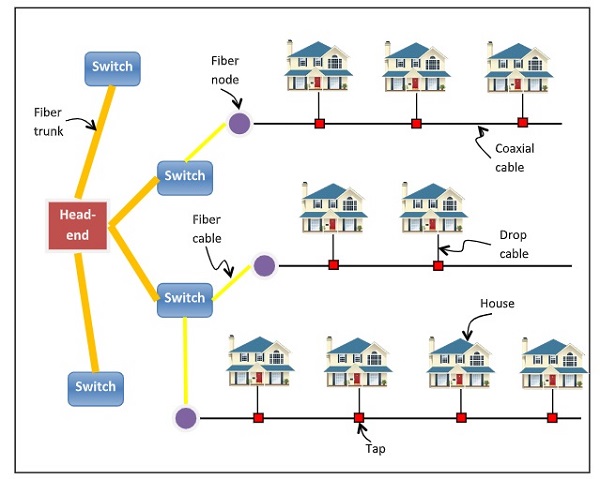
 Data Structure
Data Structure Networking
Networking RDBMS
RDBMS Operating System
Operating System Java
Java MS Excel
MS Excel iOS
iOS HTML
HTML CSS
CSS Android
Android Python
Python C Programming
C Programming C++
C++ C#
C# MongoDB
MongoDB MySQL
MySQL Javascript
Javascript PHP
PHP
- Selected Reading
- UPSC IAS Exams Notes
- Developer's Best Practices
- Questions and Answers
- Effective Resume Writing
- HR Interview Questions
- Computer Glossary
- Who is Who
Cable Internet
Cable Internet is a category of broadband Internet access that uses the infrastructure of cable TV network to provide Internet services. Cable Internet provides connectivity from the Internet service provider (ISP) to the end users in a similar manner as digital subscriber line (DSL) and fiber-to-the-home (FTTH).
System Layout
Broadband cable Internet access has a cable modem termination system (CMTS) at a cable operator facility, called a headend. Headend is connected to switching centers by high bandwidth fiber trunk. Each switching center is connected to one or more fiber nodes through fiber optic cables. The local coaxial cable connects to the customer which has a cable modem to receive the services.

Features of Cable Internet
Hybrid Fiber Coax (HFC) System: The system uses a combination of fiber cables and coaxial cables. Fiber cables are used for long haul connections, fiber trunks connect the headend with switching centres and fiber cables connect switching centre with fiber node. Coaxial cables run to the individual houses. The fiber nodes are responsible for optical - electrical conversion of signals.
Cable TV networks were originally one - way traffic. So, they had one-way amplifiers. These are replaced with two-way amplifiers to enable both upstream and downstream traffic.
Peak downstream bit rates can be as high as 1 Gbps, while upstream bit rates ranges from 384 Kbps to more than 20 Mbps. One downstream channel can be connected to hundreds of cable modems.

